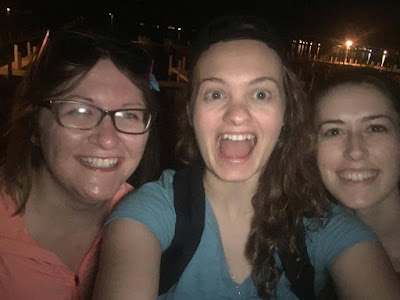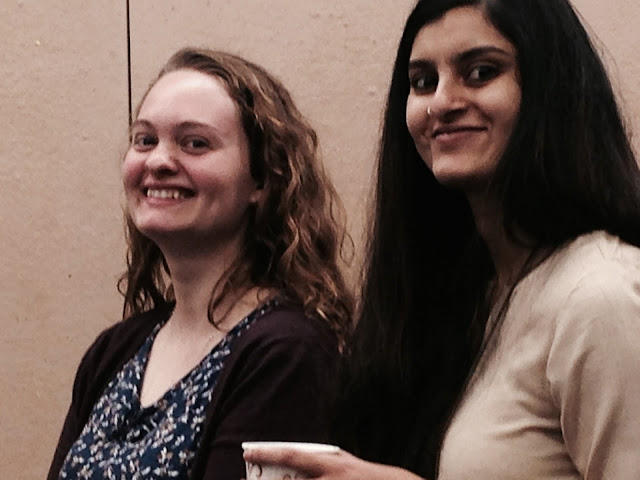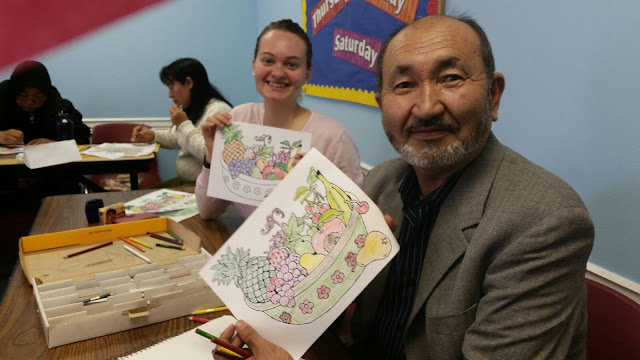It’s finally summer in Chicago again. The sun is shining,
the birds are singing, and the ice cream man is attracting droves of children
with the jingling bells on his ice cream cart. As I sit here and type this,
workmen are busy installing air conditioners in the monastery’s library
windows. The banners in the chapel are green for “OT” (Ordinary Time) again. I’ve finally come full circle: Chicago feels exactly how it did when I
arrived last August. But I feel like a completely different person.
I can’t believe I’m leaving on Sunday. It feels surreal. It’s
so weird to hear everyone making plans— for summer program, a new semester of
ESL classes, St. Scholastica’s big annual testimonial dinner—knowing that I
won’t be a part of it. It’s humbling to realize that people’s lives go on
without you.
Last Thursday I had my last day with S. Mary’s ESL class at
the Holy Spirit Life Learning Center. Everyone surprised me with a farewell
party. Sister Mary arranged two beautiful platters of chocolate and vanilla
mini-cupcakes, and Fabienne had all the children of the ESL students paint
pictures for me. But it was the students themselves that completely shocked me.
Each one wrote me an individual card, in Spanish and English, and bought me a
gift. I found out later that they had all called Fabienne the week before, asking
what she thought I would like. They gave me scarves, jewelry, chocolates.. even
a clock decorated with a picture of the Chicago skyline, as a reminder of my
time here.
I was reading a card from one of my students, a full letter
written in near-perfect English, when I realized something— I really made a
difference in this person’s life. Of course that’s what I always hoped to do,
but it comes on gradually, so slow you don’t even notice it. Making a
difference is not about doing something big at all. The difference is in the
little things: showing up to class every day and wanting to be there. Really
listening to a person while they talk. Asking a follow-up question to show that
you understand what they’re saying and that you care. It’s so small, it feels like just a drop in
the bucket. But it’s something, and it matters.
The other thing I’ve figured out this year is that you don’t just
swoop in and “make a difference” in someone’s life without them making a
difference in yours. It has to be an equal exchange or it doesn’t count. And I
can honestly say that I am a different person because of my students. They have
every reason to be tired, worn-down, bitter, angry. And sometimes they are. But
still they invite me into their lives and allow me to know them. I am constantly
blown away by the sheer force of their generosity, as evidenced both by their
material gifts and the gift of themselves. Every day they show me what it means
to give, and as a result, I give more of myself than I could have imagined at
the beginning.
The rest of this week brings more “lasts.” The last episode
of Dancing with the Stars, which I will watch with S. Patti and S. Rita over a
bag of Cheetos and a glass of wine tonight. My last art class with the
infirmary sisters, where I will hopefully finish the watercolor sunflowers I
have been working on for the last two weeks. My last day with the kids at the
Indo American Center. They keep asking me over and over, "Why are you leaving us? Why do you have to go back to Minnesota? You'll be here next year right?" I still don't really know what to say. These are really hard questions to answer.
Sister Joan Chittister said, “Every stage of life has a joy
of its own. Refusing to move on only denies us that new pleasure.” I think she
is right, and that’s how I am trying to approach this transition. But I also
believe that what makes it hard to move on from a place
is when you’ve experienced as many joys as I have here. As I prepare to move forward, I feel so grateful for each and every one of these joys, and the people in Chicago—sisters,
oblates, students, staff, children, immigrants, coworkers— that have brought
joy into my life and changed me for the better.
 |
| Sister Mary and me, at the Holy Spirit Life Learning Center |
 |
| Our advanced English class after the surprise party |
 |
| An adorable thank you note from 4-year-old Janet (with help from Fabienne) |
 |
| Enjoying the sun on the first nice day of the year |
 |
| We love park day SO MUCH |
 |
| Caught in the act (of reading) |
 |
| Reading Rainbow Fish. She tells me every day "I am going to miss you so much." |

































